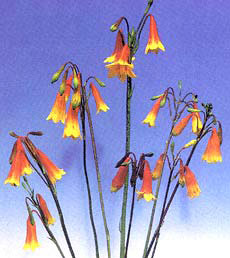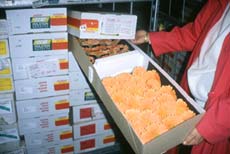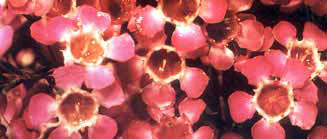
Postharvest care of cut flowers
Date: 29 Nov 2002 Author: Bettina Gollnow, Neil Wade
Ensuring maximum vase life
Maximum vase life is essential to assure buyer and consumer confidence in fresh flowers. The factors discussed here all contribute to the postharvest life of flowers and need the attention of growers and marketers.
Only the best quality flowers and foliage should be picked for market. Cut flowers and foliage begin to deteriorate as the reserves of moisture and food present at harvest start to run out. Correct handling will ensure the longest possible vase life:
- Place stems into buckets of clean water as soon as possible after harvest and promptly transport flowers to a cool location.
- Cull any unsaleable stems and sort and grade the remainder according to market requirements (parameters include stem length, diameter, flower size, bunch size, bunch ties, and sleeves).
- Once your product is bunched, store it in water with the appropriate additives.
- Hold your flowers in a coolroom at the appropriate temperature (usually 2°C to 4°C, but higher for tropical species) until it is time to market them.
Flower maturity
Some flowers are cut while still in bud or when partly open in order to make storage, packing and transport easier and to prolong market availability.
- Cut the flower only at a stage after which the buds can fully open.
- Flowers for the domestic market should be marketed at a more open bud stage than flowers that are destined for export.
- Different markets require flowers at different stages of maturity, so check with your exporter for details.
Food supply
In a living plant, starch and sugars (carbohydrates) are stored in stems, leaves, and flowers. These stored foods are needed to sustain the cut flower after harvest, and to allow flowers picked in bud to open. Feeding sugars to cut flowers can supplement the food reserves of the flower; this is a common practice with traditional flower crops.
Sugar solutions

Christmas bells
Sugar solutions are not always beneficial for native flowers, and must be used with care. (Some natives that do benefit from sugar are kangaroo paws, thryptomene, Christmas bells (pictured at right) and Verticordia.) You can prolong the postharvest life or flowering display of such flowers by pulsing them after picking, that is, putting the stems in a sugar solution (100 grams of sugar per litre of water is often adequate), usually for 12–16 hours.
A biocide is always added to the sugar solution to prevent microbial growth. Uptake of the pulsing solution depends on temperature. Pulsing is commonly carried out in the coolroom, but if you need to give a quick pulse treatment, do it at room temperature (25°C to 30°C). The times suggested for pulsing are a guide only; the only sure way to administer a pulse is to measure solution uptake. Some flowers show a response to pulse treatment only when they are refrigerated during subsequent handling.
A larger number of native flowers may benefit from having a small amount of sugar added to the vase solution (where uptake is continuous), rather than being treated by pulse application. Sugar can prevent flowers (particularly those with woody stems) from rehydrating properly when placed in water, and high concentrations (more than 10–20 g/L) can cause excessive nectar production or make leaves dry out.
No general recommendation can be made for the treatment of native flowers with sugar. Specific advice should be sought for each species. Where no information is available, tests can be done on small quantities of flowers, but it is unwise to treat large quantities as a matter of course.
Suppliers of postharvest solutions can be found in industry magazines and newsletters.
Temperature
Temperature affects the rate of transpiration (water loss) from plant parts, and therefore postharvest decline. To ensure a good vase life, you need to cool flowers rapidly after picking — this is called removing the field heat. You must then store them at low temperatures. For most flowers, a suitable storage temperature is between 1°C and 4°C.
Species that grow naturally in tropical climates need warmer storage temperatures (minimum 10°C) to avoid injury. Fluctuating temperatures during transport are one reason cut flowers may reach market in poor condition, even though they may have been in a top-quality condition when they were packed. Small temperature loggers may help to determine when the temperatures are getting too high; these are especially useful in shipments of flowers for export.
Water supply and water quality
Most flower and foliage types are very sensitive to drying out, especially those with a large leaf area. Many native flower lines have woody stems which tend to need more water. You can reduce water loss by storing at low temperatures and maintaining high relative humidity (95% to 98%) in the coolroom or package. Under these conditions, you can store stems either wet (in buckets of water) or dry (wrapped and packed inside boxes).
The water you put in the buckets must be clean, that is, free of bacterial contamination. It should have an acidic pH (you can add 0.03% citric acid to bring the pH down to 3.0–3.5), as this improves the flow rate of the solution up the stems.
You should also add a biocide to prevent rapid multiplication of bacteria in the water. Common biocides are:
- hypochlorite (bleach) — hypochlorite (as available in household bleach or swimming pool chlorine) is the most commonly used biocide, but it needs to be replenished regularly;
- granulated chlorine (sodium dichloroisocyanurate or SDIC) — a more stable source of chlorine that lasts up to 5 days; most native flowers cope with low concentrations of chlorine (20–50 ppm).
You should also regularly clean your buckets with a biocide.
Important note
When making up solutions that contain both acidifiers (like citric acid) and chlorine products (like bleach or granulated chlorine), it is important to add each substance to the water in turn after mixing in thoroughly. Bleach added to undissolved citric acid gives off harmful fumes.
Problems

Gerberas, packaged ready for shipping
Air embolisms
Air embolisms result when small air bubbles are drawn into the stem at cutting or during dry storage. They effectively block later flow of water up the stem, so that the flower wilts. You can remove embolisms by cutting off, at an angle, the lower 3 cm of the stem while the stem remains under water. The water must then be replaced frequently. Dirty water causes stem blockage and reverses the benefit of cutting under water. Placing stems into acidic water and using warm water (40°C) also help reduce the occurrence of air embolisms.
Physiological and bacterial plugging
When plant cells are wounded by cutting, the plant naturally produces substances to seal the wound. These substances can block water flow. This is called physiological plugging.
Woody stems are more prone to bacterial plugging. Bacteria and other microbes that plug stems may be present even in potable water from the tap, but are most abundant in vase, bucket and recutting water that is not replaced regularly, or in water that has been put into containers that have not been properly cleaned.
Ethylene
Ethylene gas is released by ripening fruit, leaf and stem trimmings, burning wood and cigarettes, and is also present in motor vehicle exhausts. Several flowers are sensitive to ethylene, which damages them and/or reduces their vase life:
Ethylene-sensitive flowers*
|
Traditional flowers |
Native flowers† |
|
|---|---|---|
|
|
|
* Some varieties or species of a listed genus are less sensitive, or even insensitive, to ethylene, for example some Geraldton waxes.
† Not all native flowers have been tested for their ethylene sensitivity.
Most flowers are little affected by the amounts of ethylene that they are likely to encounter during marketing. However, where sensitivity of flowers to ethylene is a commercial problem, there are products available which will protect these flowers from accidental exposure during handling. One such product is silver thiosulfate (STS).

Geraldton wax, an ethylene-sensitive native flower
Mechanical damage
Product quality is reduced when bruised and broken flowers, leaves and stems are present. Wounding often causes ethylene to be released, and can result in disease organisms entering the wound.
Pests and diseases
Pests and diseases present in an export shipment of cut flowers may result in the shipment being condemned, or refumigated at the grower’s expense.
Flowers are very susceptible to grey mould fungus (Botrytis cinerea). This disease may be latent, and develop only during shipping. Grey mould is favoured by free moisture on the flowers and foliage. Native flowers that produce lots of nectar may be more susceptible to grey mould problems. You may need to dip the cut flowers in an appropriate fungicide before shipping.
Key references
The information provided above is covered in much more detail in the following key references. These also include specific postharvest information for a large number of flower and foliage species.
Jones, R 2001, Caring for cut flowers, 2nd edn, Landlinks Press, Collingwood, Victoria, Australia. Contact CSIRO Publishing for more information.
Faragher, J, Slater, T, Joyce, D & Williamson, V April 2002, Postharvest handling of Australian flowers — from Australian native plants and related species, RIRDC Publication No. 02/021.

